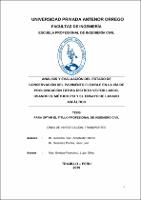| dc.contributor.advisor | Lujan Silva, Enrique Francisco | |
| dc.contributor.author | Guerrero Díaz, Zenefelder Martin | |
| dc.contributor.author | Gutierrez Portilla, Isaac Levi | |
| dc.creator | Guerrero Díaz, Zenefelder Martin | |
| dc.date.accessioned | 2019-05-21T19:26:36Z | |
| dc.date.available | 2019-05-21T19:26:36Z | |
| dc.date.issued | 2019 | |
| dc.identifier.uri | https://hdl.handle.net/20.500.12759/4833 | |
| dc.description.abstract | La presente tesis trata del análisis y evaluación del estado de conservación
del pavimento flexible en la vía de prolongación Fátima distrito Víctor Larco,
usando el método PCI y el ensayo de lavado asfaltico, investigación realizada
con uno de los métodos más empleados en varios países de América “PCI”
(Índice de Condición del Pavimento), el cual consiste en identificar el tipo de
falla, severidad de falla y cantidad de fallas; a su vez el ensayo de lavado
asfaltico citado en el MTC E 502 como un ensayo de análisis complementario
el cual realiza la verificación cuantitativa de la mezcla asfáltica del pavimento
y la granulometría de sus agregados.
Con el objetivo principal de determinar la relación entre estos dos métodos de
análisis, se realizó un levantamiento en campo y trabajo en laboratorios de la
Universidad Privada Antenor Orrego.
En el pavimento flexible de la vía antes mencionada, calculamos unidades de
muestreo (UM) de 30 metros cada una, teniendo 58 unidades de muestreo de
30 metros y 2 de 17 metros, en cada unidad de muestreo se detectaron las
diferentes tipologías de fallas de las cuales se encontró en mayor cantidad la
falla denominada “Meteorización / Desprendimiento de agregados”. Así
también 10 puntos de muestreo aleatorios en toda la vía.
Metodológicamente el tipo de investigación fue de tipo de campo experimental
y no experimental, descriptiva y explicativa, de enfoque calificativo y
cuantitativo.
Dentro de las conclusiones más importantes se señala que con este análisis
y evaluación, hemos obtenidos que el pavimento flexible tiene una condición
de 53.5 % de estado REGULAR, que es un promedio del total de unidades en
ambos tramos y 4 unidades de muestreo con porcentajes de bitumen
aceptable. Estos datos fueron procesados en el programa Excel, diseñado
para aplicar el Método del Índice de Condición del Pavimento (PCI) en
pavimentos flexibles.
Palabras Claves: (PCI), Método del Índice de Condición del Pavimento y
(porcentaje de Bitumen) compuesto de hidrocarburos pesados utilizado para
construcción. | es_PE |
| dc.description.abstract | The present thesis deals with the analysis and evaluation of the state of
conservation of the flexible pavement in the Fátima prolongation road Víctor
Larco district, using the PCI method and the asphalt washing test, research
carried out with one of the most used methods in several countries of America.
““PCI““ (Pavement Condition Index), which consists in identifying the type of
fault, severity of failure and number of faults; In turn, the asphalt washing test
cited in the MTC E 502 as a complementary analysis test which performs the
quantitative verification of the asphalt mixture of the pavement and the
granulometry of its aggregates.
With the main objective of determining the relationship between these two
methods of analysis, a survey was carried out in the field and work in
laboratories of the Universidad Privada Antenor Orrego.
In the flexible pavement of the aforementioned road, we calculated sampling
units (UM) of 30 meters each, having 58 sampling units of 30 meters and 2 of
17 meters, in each sampling unit the different types of failure were detected.
which was found in greater quantity the fault called ““Weathering/raveling““. So
also 10 random sampling points in the whole road.
Methodologically, the type of research was experimental and nonexperimental,
descriptive and explanatory, with a qualitative and quantitative
approach.
Among the most important conclusions is that with this analysis and evaluation,
we have obtained that the flexible pavement has a condition of 53.5% of
REGULAR status, which is an average of the total of units in both sections and
4 sampling units with percentages of acceptable bitumen. These data were
processed in the Excel program, designed to apply the Pavement Condition
Index (PCI) Method in flexible pavements.
Key Words: (PCI), Pavement Condition Index Method and (percentage of
Bitumen) composed of heavy hydrocarbons used for construction. | en_US |
| dc.description.uri | Tesis | es_PE |
| dc.format | application/pdf | es_PE |
| dc.language.iso | spa | es_PE |
| dc.publisher | Universidad Privada Antenor Orrego | es_PE |
| dc.relation.ispartofseries | T_ING.CIVIL_1724 | |
| dc.rights | info:eu-repo/semantics/closedAccess | es_PE |
| dc.rights.uri | https://creativecommons.org/licenses/by/4.0/ | es_PE |
| dc.source | Universidad Privada Antenor Orrego | es_PE |
| dc.source | Repositorio Institucional - UPAO | es_PE |
| dc.subject | Conservación | es_PE |
| dc.subject | Método PCI | es_PE |
| dc.title | Análisis y evaluación del estado de conservación del pavimento flexible en la vía de prolongación Fátima distrito Víctor Larco, usando el método PCI y el ensayo de lavado asfáltico | es_PE |
| dc.type | info:eu-repo/semantics/bachelorThesis | es_PE |
| thesis.degree.level | Título Profesional | es_PE |
| thesis.degree.grantor | Universidad Privada Antenor Orrego. Facultad de Ingeniería | es_PE |
| thesis.degree.name | Ingeniero Civil | es_PE |
| thesis.degree.discipline | Ingeniería Civil | es_PE |
| dc.subject.ocde | https://purl.org/pe-repo/ocde/ford#2.01.00 | |
| renati.type | https://purl.org/pe-repo/renati/type#tesis | |
| renati.level | https://purl.org/pe-repo/renati/level#tituloProfesional | |
| dc.publisher.country | PE | es_PE |


